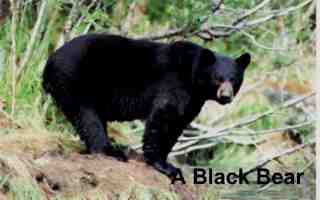Contents

American
Black Bears

American black bears are the most
widespread and numerous bears in North America. They inhabit most of the
continents forest areas, beginning at the Northern tree limit of the Arctic,
south throughout much of the United States, and down the wooden Sierra
Madre Mountains into the northern Mexico. East and West, they range
from Newfoundland to British Columbia's queen Charlotte Islands.
Habitat
Preferences and Relative Abundance
In all parts of their range, black bears
prefer forests with intermittent open areas (meadows) that provide them
with numerous berries and other desirable foods. They are most abundant
in the mixed hardwood forests of the east and in the vast coniferous forests
rimming the Pacific Northwest. They are least common on the Great Plains.
It is difficult to accurately determine the number of black bears alive
today. Some of our best estimates place the total population for all of
North America somewhere between 400,000 and 750,000. (Because these estimates
come from scientists, the numbers are probably rather conservative.
Food
Habits
Whatever its color, the American black bear
is a four-legged garbage grinder when it comes to eating. Everything in
the forest is a fair game. In the day they may feed on berries, animal
carcasses, dead fish washed up on the shore of a lake, ants and other insects,
acorns and beechnuts, wild cherries, honey (which they are extremely fond
of), grass and herbs —practically anything edible. Research has shown,
however, that these bears subsist mainly as vegetarians. Less than 25 percent
of heir diet is composed of animal matter. Their food habits vary greatly
with seasonal availability and location. Black bears on the West Coasts
live primarily on berries, fish, and marine invertebrates found along beaches
and in tidal pools. In Alaska, black bears kill moose calves and fish
salmon. In northern Canada they eat lemmings when they can catch them.
Food is a frequent cause of contention between black bears and people.
These extremely intelligent and rather shy bears are the only bear species
in North America that has adapted to civilization. To these bears, people
and their belongings often mean just one thing that is "food". Cabins, camps, food
caches, garbage cans, and town dumps are often raided by bears looking
for an easy meal. Its amazing the amount of damage a hungry bear can do
to a house or truck camper when it is trying to get in. I have seen entire
walls ripped splinters by bears who smelled food on the other side.
Vital
Statistics
Black bears are the smallest of the Northern American
bears. On the average, adults stand from 35 to 40 inches (89 to 102 cm)
high when all fours and from 4.5 to 6 feet (1.37 to 1.82 m) in length,
including a short tail some 5 inches 913 cm) long. Weighs are highly variable,
ranging from 125 to over 600 pounds (57 to 272 kg). Size and weight vary
considerably and depend on food availability in the area where the bear
lives. Males are usually about a third larger than females.
The
Hibernating Black Bear
As fall approaches, black bears become very
fat. In a frenzy of late- summer eating, they may gain as much as 30 pounds
(14 kg) a week. This is their last chance to get in shape for winter. Just
prior to denning time, the bears stop feeding, their stomachs becoming
shrunken and half rigid. In this condition, the bears retire to a cave
or hollow log and become dormant. Quite often they will drag leaves and
tree branches into the hole to make a cozy nest. In the Great Smoky Mountains
and elsewhere in the U.S. Southeast, most bears den above ground in tree
cavities formed in wind damaged hardwood trees. Sleeping chambers are enlarged
by scraping the cavity walls; the punky woods chips are then used as bedding
material. Black bears in northern Canada den earlier and remain in their
dens much longer than those in the South. After the first frost of September
they seek out their den sites and are usually in hibernation by October.
They emerge from their dens in late April, looking gaunt after their long
fast. In Idaho, black bears dig their dens in October and enter in early
November, remains there until mid April. In Florida, and probably in
other Southeastern States, most black bears except pregnant females, remain
active through the winter. (A northern bear that does not have sufficient
fat for hibernating may also be active all winter.) Body temperatures of
hibernating black bears range from 91.4 F to 99.4 F (33 to 37.4 C). Black
bear blood has more , but smaller, circulating red blood cells than do
humans or dogs. This condition appears to be an advantage to a hibernating
species because it increases the surface area of its red corpuscles. This
in turn provides a more efficient exchange of oxygen and carbon dioxide.
Spring is a negative forage time for hibernating bears; the usually continue
to lose weight for a couple of months after leaving the dens, or just maintain
it if they're lucky. By the time summer's abundance arrives, life become
a nonstop effort to eat and gain weight.


 by: John Froilan Reyes
by: John Froilan Reyes
